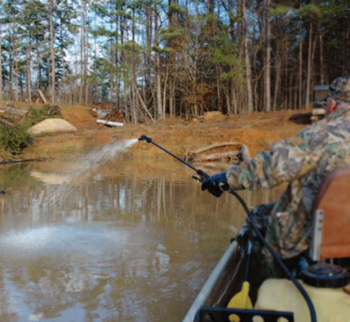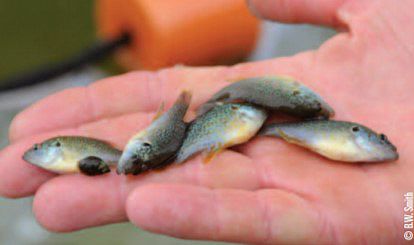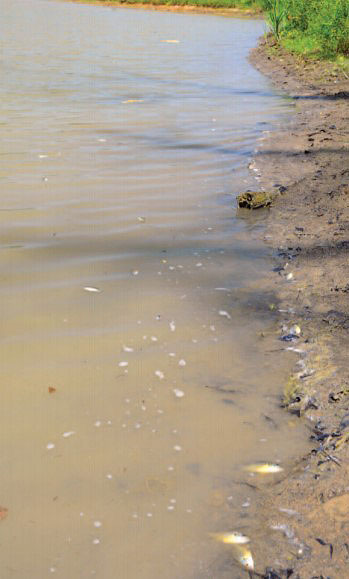Barry W. Smith | Originally published in GameKeepers: Farming for Wildlife Magazine. To subscribe, click here.

As those of you who have constructed new ponds know, there is a substantial financial investment in building a lake or pond. It seems that new pond owners often focus on many of the construction considerations of pond building, such as depth, structure, slopes of the banks and dam, drain pipes, valves and many other physical characteristics and yet overlook one of the most important factors influencing the success of their pond stocking…eliminating wild fish.

from a sprayer. Here the basin had enough water to
apply form a small boat.
We always ask new pond owners, “Are there any wild fish in your new pond?” The typical response is, “There couldn’t be, the pond was almost dry.” If an existing pond had been drained and renovated, the common response would be, “Well, there was a little puddle, but is was so hot and shallow that nothing could have survived.” These are assumptions that are usually not valid and it is certainly worth the small effort and expense to treat any water in the basin and watershed with an approved fish toxicant prior to stocking.
Most ponds are built or drained and renovated during the summer. Everyone is anxious to collect water as soon as construction is complete in order to get the pond “started.” It is difficult to convince a pond owner to leave the valve open and not collect water until October. Let’s look at a couple of typical scenarios where ponds begin to catch water in the late summer or very early fall.
Your new 10-acre lake was completed during mid August and you can’t wait to have the best bass fishing lake in your area. There was a small puddle in front of the drain pipe, but it was muddy and you did not see any signs of fish activity. There just couldn’t be anything in there, so why waste the water you are expecting from the rain they are predicting next week. You were almost right; there wasn’t much in there… maybe a half dozen green sunfish that were only 2 to 3 inches long. You did catch some water from that rain and now you have about a surface acre of water. It is not enough water to stock fish from the hatchery, but at this rate you may be ready to stock hatchery fish in October. You are completely unaware that the few little green sunfish have begun to grow rapidly and are developing eggs. Soon they are spawning, because green sunfish become sexually mature at a size of only 3 inches. In less than 30 days your population of green sunfish has grown from six to many thousands. Now you are looking at real trouble…this is why.

These little fish are fat and full of eggs.
Green sunfish have a much larger mouth than a bluegill and can out-compete bluegill for food items. This will slow the growth of the bluegill that are stocked form the hatchery. By the time the lake fills and is ready for the fingerling bass to be stocked during early June, the green sunfish will be large enough to eat a 2-inch bass fingerling. This will dramatically decrease your survival so that the end of the first year, you will experience difficulty catching a bass because there will not be many in your lake. In addition, each time you fish for bluegill, you will catch mostly green sunfish. The greens are much more aggressive than bluegill and will be the first fish to your bait or lure. They will also hybridize with the bluegill, producing a hybrid sunfish that does not reproduce enough to support a healthy bass population…more trouble!

Notice the abundance of green sunfish during the
October renovation.
The second scenario is you have just drained that shallow old five-acre pond and reworked the shoreline, deepened the edges and installed a new drain pipe. You have added structure and created deep travel lanes for the 10-pound bass you expect to grow in less than five years. There was just a little water left in the very middle, but with all of the construction equipment and the hot summer you are sure none of the fish could have survived. You did not have any wild fish in this old pond, so what if a few little bluegill were left, what harm could that be? You were right, there were just a few little bluegill remaining, but there were also a few 6- to 8-inch bass. What could that hurt? As the water began to expand in the late summer and fall, a few of the bluegill began to spawn and the little bass began to grow. When the lake had enough water to stock in the late fall, the bass started munching on the 2-inch bluegill provided by the hatchery. The real problem is not how many of the bluegill you just bought are being eaten; it is what is going to happen later in the spring when these fat young bass spawn. Instead of stocking 50 to 100 bass fingerlings per acre in early June, your lake is going to have a thousand bass fingerlings per acre from natural reproduction. Instead of having the Tiger Bass from the hatchery grow more than a pound the first year, your bass will be six inches at the end of the first year and growth will not improve much for the next several years.
It should be obvious that not poisoning the remaining water in a renovated old pond or the small puddles in a new pond can be a catastrophic mistake. The chemical of choice for fish renovation and eliminating all fish from the basin and watershed is the fish toxicant rotenone. It is always best to use more rotenone than you have calculated, so that if you are going to error, it is on the side that will eliminate all of the wild fish present. A gallon of liquid 5% rotenone, or 8 pounds of powdered rotenone, should be used per acre-foot of water in the basin. This will be effective against all wild fish including bullheads and shiners. Always mix the liquid with about five parts water before applying. The powder should be mixed with enough water to make slurry, don’t put the powder directly onto the water in the pond. Try to treat even the smallest amount of water in the watershed, in addition to the puddles or large area in the basin. This is hard work and is often best accomplished by hiring a professional consultant.
Try to be patient, wait until October before closing the drain valve and applying rotenone. If you miss a few wild fish that are hiding in a stump hole, the water temperature will be cold enough in October to prevent spawning. Call a professional fisheries biologist and start your lake the correct way.































